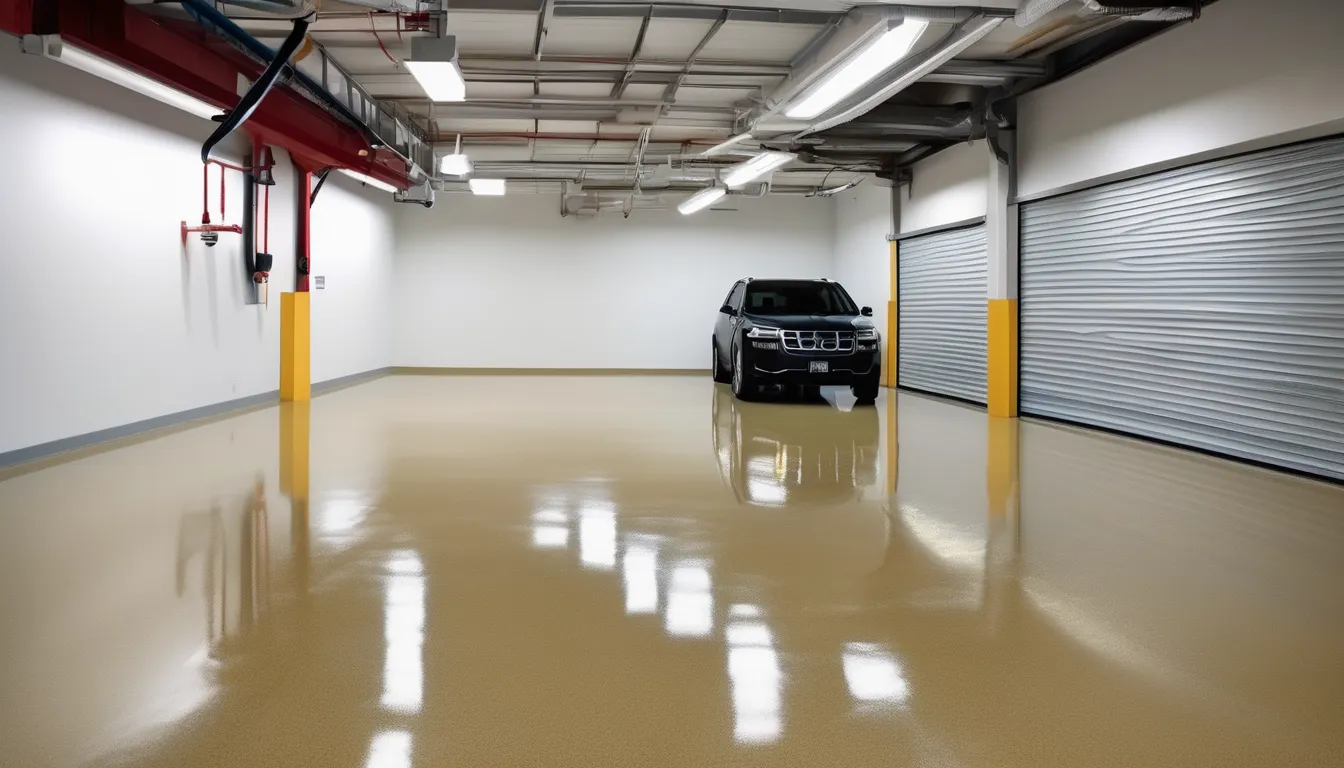When it comes to maintaining your garage floor coatings, you might think it requires a lot of effort, but it doesn’t have to. By regularly sweeping and addressing spills quickly, you can significantly extend the life of your floor. Using the right cleaning supplies and techniques makes all the difference, but there’s more to it than just routine cleaning. Understanding the nuances of your specific coating type can unlock even greater benefits. Curious about how to tackle stubborn stains or when to apply a sealant? Let’s explore these essential tips further.
Understanding Garage Floor Coatings
When it comes to garage floor coatings, understanding the different types available is essential for making the right choice.
You’ve got several options, each with unique benefits and drawbacks. Epoxy coatings are popular due to their durability and resistance to chemicals, making them ideal if you work on cars or store hazardous materials. They bond well to concrete, creating a tough surface that withstands wear.
Polyurea coatings, on the other hand, cure quickly and can be installed in a single day. They’re flexible and resistant to UV rays, which prevents fading and yellowing over time. If you live in a climate with temperature fluctuations, this might be a better fit garage epoxy flooring you.
If you’re looking for an aesthetic upgrade, consider decorative coatings like flake or metallic finishes. These not only enhance the look of your garage but also provide a protective barrier.
Essential Cleaning Supplies
To keep your garage floor coatings looking great and performing well, having the right cleaning supplies on hand is important. Start with a quality broom or dust mop to remove loose dirt and debris. This’ll help prevent scratches and keep your floor looking pristine.
Next, grab a stiff-bristled brush for tougher stains. It’ll help you scrub away grime without damaging the coating.
You’ll also need a mop, ideally a microfiber one, for applying cleaner and wiping down the surface. Don’t forget a bucket for mixing your cleaning solution. Choose a pH-balanced cleaner specifically designed for garage floors, as harsh chemicals can harm the coating.
For tougher stains, a degreaser can be a lifesaver. Keep a spray bottle handy for quick spot cleaning; it’ll save you time and effort.
Lastly, rubber gloves and safety goggles are essential for protecting yourself while you clean.
With these supplies in your cleaning arsenal, you’ll be well-equipped to maintain your garage floor coatings effectively. Regular upkeep with the right tools will ensure your floors stay in top shape for years to come.
Step-by-Step Cleaning Process
A clean garage floor not only enhances the overall appearance of your space but also extends the life of your floor coatings. To keep your garage looking its best, follow this step-by-step cleaning process.
First, start by clearing the floor of any debris, tools, or items. This gives you a clear workspace.
Next, sweep or vacuum the floor to remove loose dirt and dust. Don’t forget those corners!
Once the surface is clear, prepare your cleaning solution. If you’re using a commercial cleaner, follow the manufacturer’s instructions. For a DIY solution, mix warm water with a few drops of dish soap.
Now, grab a mop or a scrub brush and apply the cleaning solution to the floor. Work in small sections, scrubbing away any stubborn stains. Let the solution sit for a few minutes to break down grime.
After scrubbing, rinse the floor with clean water, ensuring you remove all soap residue.
Preventive Maintenance Tips
Maintaining your garage floor coatings is essential for preventing damage and ensuring longevity. Start by regularly sweeping or vacuuming the floor to remove dirt and debris that can scratch the surface.
Make it a habit to clean spills immediately, especially oils or chemicals, as they can break down the coating if left unattended.
Consider applying a sealant every few years to provide an additional layer of protection against wear and tear.
Avoid using harsh chemicals or abrasive tools when cleaning, as these can damage the coating—stick to mild detergents and soft brushes instead.
If you notice any signs of damage, such as cracks or peeling, address them promptly to prevent further deterioration.
It’s also a good idea to minimize the weight of items stored in your garage, as excessive weight can lead to floor damage.
Lastly, keep your garage well-ventilated and dry to reduce moisture buildup, which can weaken coatings over time.
Troubleshooting Common Issues
Even with regular maintenance, you might encounter some common issues with your garage floor coatings. One of the most frequent problems is peeling. This usually happens when moisture gets trapped beneath the coating. To fix this, you’ll need to remove the damaged area, allow it to dry completely, and then reapply the coating.
Another issue is discoloration, which can be caused by exposure to chemicals or UV light. To address this, clean the affected area with a mild detergent and water, and consider applying a UV-resistant sealant to protect against future fading.
If you notice a rough texture on your floor, it might be due to improper mixing of the coating materials. In this case, you can lightly sand the surface and reapply a fresh coat to restore a smooth finish.
Lastly, if you see stains that won’t come out, try using a specialized cleaner designed for your floor type. For stubborn spots, a power washer can work wonders, but make sure to follow up with a sealant to maintain the floor’s integrity.
Conclusion
By following these simple cleaning tips, you can keep your garage floor coating looking great and lasting longer. Regular maintenance, like sweeping and addressing spills promptly, helps prevent damage. Don’t forget to use the right supplies and techniques for tough stains. With a little effort, you’ll ensure your garage remains a clean and functional space. Remember, a sealant every few years can provide extra protection, making your maintenance routine even easier. Happy cleaning!

